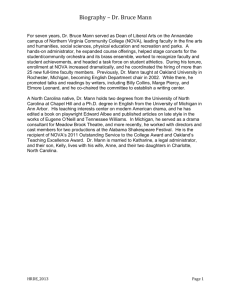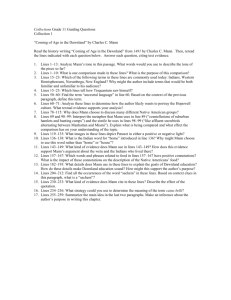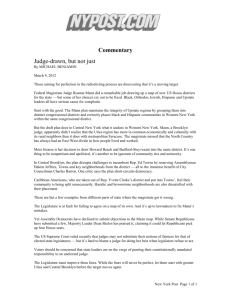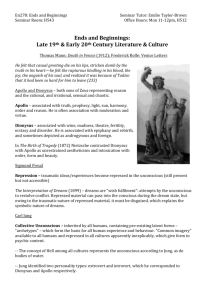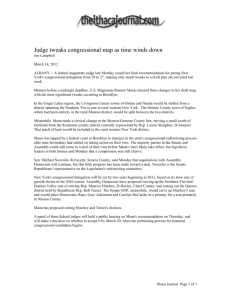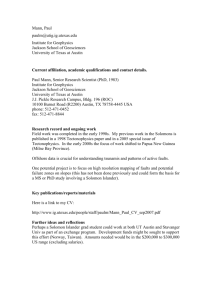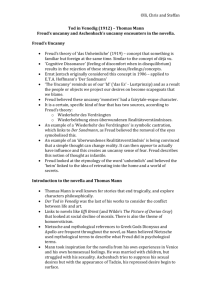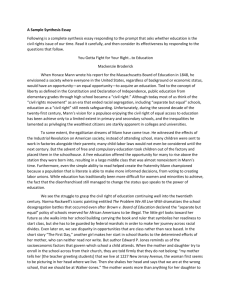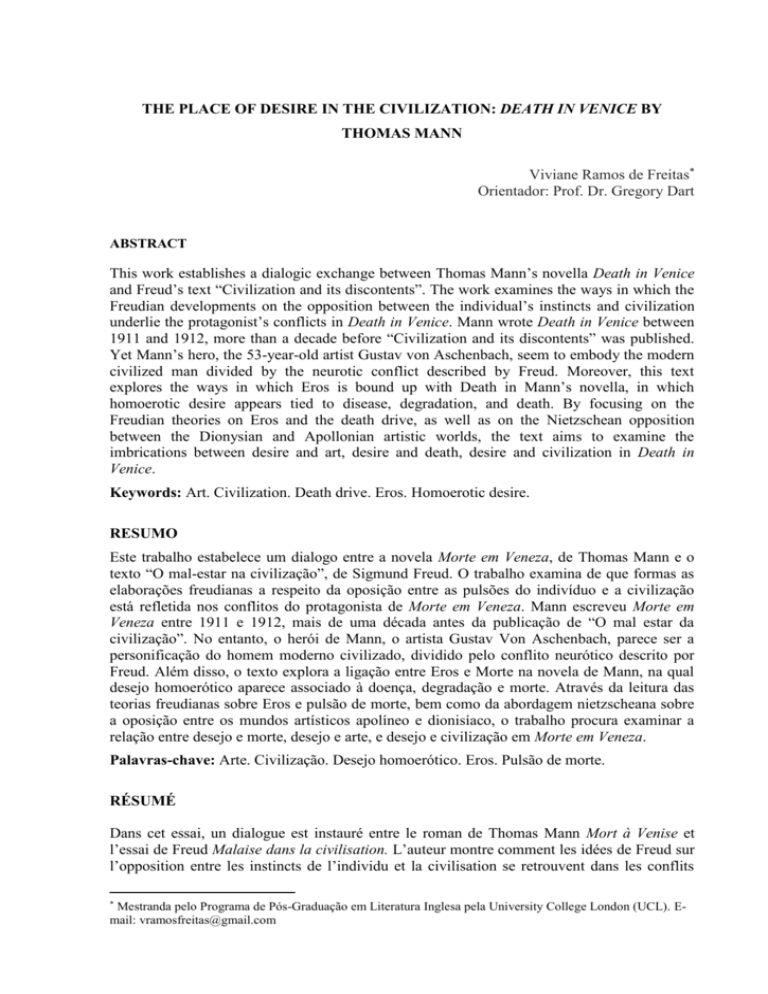
THE PLACE OF DESIRE IN THE CIVILIZATION: DEATH IN VENICE BY
THOMAS MANN
Viviane Ramos de Freitas
Orientador: Prof. Dr. Gregory Dart
ABSTRACT
This work establishes a dialogic exchange between Thomas Mann’s novella Death in Venice
and Freud’s text “Civilization and its discontents”. The work examines the ways in which the
Freudian developments on the opposition between the individual’s instincts and civilization
underlie the protagonist’s conflicts in Death in Venice. Mann wrote Death in Venice between
1911 and 1912, more than a decade before “Civilization and its discontents” was published.
Yet Mann’s hero, the 53-year-old artist Gustav von Aschenbach, seem to embody the modern
civilized man divided by the neurotic conflict described by Freud. Moreover, this text
explores the ways in which Eros is bound up with Death in Mann’s novella, in which
homoerotic desire appears tied to disease, degradation, and death. By focusing on the
Freudian theories on Eros and the death drive, as well as on the Nietzschean opposition
between the Dionysian and Apollonian artistic worlds, the text aims to examine the
imbrications between desire and art, desire and death, desire and civilization in Death in
Venice.
Keywords: Art. Civilization. Death drive. Eros. Homoerotic desire.
RESUMO
Este trabalho estabelece um dialogo entre a novela Morte em Veneza, de Thomas Mann e o
texto “O mal-estar na civilização”, de Sigmund Freud. O trabalho examina de que formas as
elaborações freudianas a respeito da oposição entre as pulsões do indivíduo e a civilização
está refletida nos conflitos do protagonista de Morte em Veneza. Mann escreveu Morte em
Veneza entre 1911 e 1912, mais de uma década antes da publicação de “O mal estar da
civilização”. No entanto, o herói de Mann, o artista Gustav Von Aschenbach, parece ser a
personificação do homem moderno civilizado, dividido pelo conflito neurótico descrito por
Freud. Além disso, o texto explora a ligação entre Eros e Morte na novela de Mann, na qual
desejo homoerótico aparece associado à doença, degradação e morte. Através da leitura das
teorias freudianas sobre Eros e pulsão de morte, bem como da abordagem nietzscheana sobre
a oposição entre os mundos artísticos apolíneo e dionisíaco, o trabalho procura examinar a
relação entre desejo e morte, desejo e arte, e desejo e civilização em Morte em Veneza.
Palavras-chave: Arte. Civilização. Desejo homoerótico. Eros. Pulsão de morte.
RÉSUMÉ
Dans cet essai, un dialogue est instauré entre le roman de Thomas Mann Mort à Venise et
l’essai de Freud Malaise dans la civilisation. L’auteur montre comment les idées de Freud sur
l’opposition entre les instincts de l’individu et la civilisation se retrouvent dans les conflits
Mestranda pelo Programa de Pós-Graduação em Literatura Inglesa pela University College London (UCL). Email: vramosfreitas@gmail.com
Viviane Ramos de Freitas
Mots-clefs: Art. Civilisation. Eros. Désir homoérotique. Pulsion de mort.
1 IN THE SERVICE OF CIVILIZATION
The place of desire in the civilization has always been problematic. Civilization
was founded with the inauguration of the law and rules that aimed to protect men
against nature and to regulate their mutual relations, but these same laws presuppose the
coercion and the renunciation of instincts. In “Totem and Taboo” (FREUD, 2001c),
Freud identifies the beginning of civilization with the incest taboo, the taboo against
killing the totemic animal and the prohibitions of the totemic system, which were built
up upon the individuals’ renunciation of sexual and aggressive instincts. In
“Civilization and its discontents”, he goes further to say that “the price we pay for our
advance in civilization is a loss of happiness.” (FREUD, 2001b, p. 134) According to
Freud, “a person becomes neurotic because he cannot tolerate the amount of frustration
which society imposes on him” (FREUD, 2001b, p. 87), and he emphatically warns
against the danger of the suppression or repression of man’s powerful instincts: “If the
loss is not compensated for economically, one can be certain that serious disorders will
ensue.” (FREUD, 2001b, p. 97) This warning is predictive of Mann’s hero fate in Death
in Venice.
In the first lines of Death in Venice we are told that “a grave a threat seemed to
hang over the peace of Europe.” (MANN, 1998, p. 197) A few lines below we read that
the protagonist, the renowned writer Gustav von Aschenbach, is also going through a
personal crisis, which manifests itself as an acute case of writer’s block. Aschenbach is
not only an exemplary writer who represents the interests of the German nation, but he
2
Revista Inventário- 11ª edição- Jul. - Dez. – 2012 - www.inventario.ufba.br. ISSN 1679-1347
internes du protagoniste de Mort à Venise. Mann écrit Mort à Venise entre 1911 et
1912, plus de dix ans avant la publication de Malaise dans la civilisation. Il semble
toutefois que le héros de Mann, l’artiste de 53 ans Gustav von Aschenbach, personnifie
l’homme civilisé moderne, victime du conflit névrotique décrit par Freud. Qui plus est,
l’essai examine les liens étroits entre Eros et Thanatos dans le roman de Mann, en ceci
que le désir homoérotique semble lié à la maladie, la misère et la mort. En mettant
l’accent sur les théories freudiennes des instincts de vie et de mort, ainsi que sur
l’opposition nietzschéenne entre les mondes artistiques dionysien et apollinien, l’essai
interroge les imbrications entre le désir et l’art, le désir et la mort ainsi que le désir et la
civilisation dans Mort à Venise.
The place of desire in the civilization: Death in Venice by Thomas Mann
is also a representative writer of Europe. He is concerned with “the tasks imposed upon his
own sensibility and by the collective European psyche” (MANN, 1998, p. 200). In this regard,
it is telling the fact that, the crisis in the European civilization, on the eve of the First World
War, coincides with the protagonist’s personal crisis.
3
In multiple ways, Aschenbach is an artist in the service of civilization. He is a
Revista Inventário- 11 ª edição- Jul.- Dez. - 2012- www.inventario.ufba.br. ISSN 1679-1347
respectable writer whose books become national classics. In his fiftieth birthday, he was
ennobled for his biographical epic on Frederic of Prussia, a work that evokes a patriotic
subject. The author of the novel Maya, the treatise Intellect and Art and the book A Study in
Abjection enjoys the confidence and admiration of both the intellectual elite and the general
reading public. He has also attained a high level of public esteem among younger generations
with A Study in Abjection. Moreover, Aschenbach’s conservative and formal style is held up
as exemplary by the education authority. Finally, Aschenbach honours the family legacy - his
forefathers were prominent civil servants and military officers who spent their “disciplined,
decently austere life in the service of the King and the state” (MANN, 1998, p. 202). Like
them, Mann’s protagonist is ultimately concerned with his stature in the community. We are
told that “the conscious and defiant purpose of his entire development had been […] an ascent
to dignity” (MANN, 1998, p. 206).
Aschenbach’s is an art of restraint and repression of desire. His creative process stifles
the spontaneity, fantasy and impulse, which Freud associates with the conception of
creativity, in favour of an essentially formalist, classicist art. He “curbed and cooled his
feelings” (MANN, 1998, p. 201) in pursuit of perfectionism, which he considers the
“innermost essence of talent” (MANN, 1998, p. 201). Besides, his “renunciation of all moral
scepticism, of every kind of sympathy with the abyss” (MANN, 1998, p. 207), points to the
repressive character of his work. It is implied that his cold, calculated and artificial art
expresses a lack of sympathy for human passions and sufferings.
Mann’s hero is, thus, a typical case of inhibition of sexual and aggressive instincts “in
the service of [society’s] cultural ideals” (FREUD, 2001b, p. 87), as described by Freud.
Besides, Aschenbach’s formalist art affirms bourgeois values and largely supports the
bourgeois status quo. The formal and moral aspects of his art reflect the repressive structure
of bourgeois society. In favouring constraint, order, balance, harmony, he bases his art on the
mastery of the instincts. In this regard, Aschenbach’s art is a perfect embodiment of the way
in which the desire is stifled and suppressed by bourgeois morality.
Viviane Ramos de Freitas
2 THE NEUROTIC CONFLICT
Aschenbach’s portrait is that of an artist as an aging man, and we meet him at a
point where he seems to be at the end of his tether. Not only is he exhausted,
“increasingly subject to fatigue” (MANN, 1998, p. 197), but also his artistic creativity
4
197) and his efforts to overcome it fail as he becomes paralysed by scruples of distaste
and perfectionist fastidiousness. Despite having cultivated his judgement more than his
imagination, as indicated by his treatise Art and Intellect, he laments that his work lacks
the ‘sparkling and joyful improvisation” (MANN, 1998, p. 201), a quality that he places
above “the intellect substance”. Above all, Aschenbach is aware that the work of an
artist hinges on imagination and desire. Having repressed his desire and renounced his
instinctual impulses so vehemently in favour of his formalist art, he feels now that his
intuitive powers are retreating from him: “Could it be that the enslaved emotion was
now avenging itself by deserting him, by refusing from now on to bear up his art on its
wings, by taking with it all his joy in words, all his appetite for the beauty of form?”
(MANN, 1998, p. 201).
Aschenbach’s crisis dramatically acts out the neurotic conflict described by
Freud. Mann’s protagonist is torn between the sacrifices imposed by civilization and his
own desire, a fact that becomes evident when we are told that “even as [his art] brought
him national honour he took no pleasure in it himself” (MANN, 1998, p.201). In his
pursuit of an art that could be in the service of civilization, Aschenbach repressed “the
darker, more fiery impulses” (MANN, 1998, p. 202 - 203) inherited from his maternal
musician ancestors. Considering the Nietzschean opposition between the Dionysian and
Apollonian artistic worlds, Aschenbach can be considered an essentially Apollonian
artist. His overreliance in the Apollonian features of clarity, harmony and restraint
shows a flagrant disregard for the emotional, spontaneous and sensual qualities of the
Dionysian impulse. However, it becomes apparent that as he repressed his Dionysian
“darker, more fiery impulses”, he also inhibited the erotic, libidinal energies that are
channelled into the artistic creation.
3 THE ERUPTION OF DESIRE
Revista Inventário- 11ª edição- Jul. - Dez. – 2012 - www.inventario.ufba.br. ISSN 1679-1347
is under threat. His work reaches “a difficult and dangerous point” (MANN, 1998, p.
The place of desire in the civilization: Death in Venice by Thomas Mann
Aschenbach’s need to flee his work eventually leads him to a beachfront hotel at the
Lido in Venice. On the day of his arrival, he becomes fascinated by the perfect beauty of
Tadzio, a fourteen-year-old boy who is staying with his family in the same hotel at the Lido.
At first, his contemplation of Tadzio’s beauty seems to be purely aesthetic. The feelings of joy
5
and exaltation he experiences in sight of Tadzio are compared to the ecstasy and rapture of an
Revista Inventário- 11 ª edição- Jul.- Dez. - 2012- www.inventario.ufba.br. ISSN 1679-1347
artist “confronted by a masterpiece” (MANN, 1998, p. 223). Tadzio’s “god-like beauty”
(MANN, 1998, p. 223) evokes the Greek god Eros and innumerable allusions to Greek
mythology. Aschenbach sees him as the incarnation of “a Greek sculpture of the noblest
period”. The combination of the boy’s perfect form with his “unique personal charm”
(MANN, 1998, p. 219) makes Aschenbach think he has never seen, in nature or in art,
anything more beautiful.
Aschenbach’s attempt to maintain the aesthetic character of his feelings, even as he
becomes aware of his infatuation with Tadzio, is revealed as he rationalises his homoerotic
desire by interpreting his feelings in terms of Plato’s doctrine of beauty. His frequent
allusions to passages from Platos’s dialogues Phaedrus and the Symposium ultimately argue
that Beauty is the only visible spiritual form, thus, “Beauty is the lover’s path to the spirit”
(MANN, 1998, p. 239). In this regard, as he admires Tadzio, he imagines he is “gazing on
Beauty itself, on Form as a thought of God” (MANN, 1998, p. 237). However, contrary to the
Platonic experience, Aschenbach’s love does not lead him to spiritual fulfilment, but to
“emotional intoxication” (MANN, 1998, p. 237).
One of the effects of Aschenbach’s infatuation with Tadzio is the upwelling of
repressed desires. Mann’s protagonist confirms Freud’s argument that “[…] the repressed
instinct never ceases to strive for complete satisfaction […]” (FREUD, 2001a, p. 42). The
Freudian concept of a return of the repressed is clearly expressed by Aschenbach’s
experience:
Feelings he had had long ago, early and precious dolours of the heart, which had
died out in his life’s austere service and were now, so strangely transformed,
returning to him – he recognized them with a confused and astonished smile.
(MANN, 1998, p. 242)
Aschenbach’s love for Tadzio also brought about the Dionysian impulses long
repressed and, with them, the revelation of the power of passion and instincts. The narrator’s
references to Aschenbach as “enthusiast” and to his feelings as “intoxicating emotion”
(MANN, 1998, p. 241) provide images of Dionysian states. Nietzsche describes the essence
of the Dionysian through the “analogy of intoxication” (NIETZSCHE, 2000, p. 22) and
Viviane Ramos de Freitas
associates it with the “collapse of the principium individuations”, an Apollonian
attribute. Under the spell of Tadzio, Aschenbach increasingly abandons the Apollonian
principles of clarity, rationality and moderation, which governed his exclusively
aesthetic existence, and succumbs to the Dionysian world of formless flux, music,
mysticism and excess. Aschenbach’s assertion that the heightening of the sensual
“forgets its proper states” (MANN, 1998, p. 238) can be associated with the collapse of
the principle of individuation caused by the self-abandonment and “self-oblivion of the
Dionysian state” (NIETZSCHE, 2000, p. 32).
Furthermore, the eruption of Aschenbach’s repressed desires causes the release
of erotic, libidinal energies that are potentially directed towards the artistic creation. His
passion awakens his desire to write. He strongly wishes to work on an essay in Tadzio’s
presence, with the music of his voice in his ears, so that he can take the boy’s beauty
and forms as a model, and shape his style upon the lineaments of Tadzio’s body.
However, while Aschenbach thinks of his work in terms of spiritual
achievement, disregarding the sensual, or sexual motives involved, the narrator opens
the hero’s Platonism to question when he makes remarks on the origins and conditions
of artistic creation. The narrator claims that knowing the sources of an artist’s
inspiration would often confuse and shock readers and lead to a depreciation of the
artistic work. After having finished writing his essay inspired by Tadzio, Aschenbach
notes that “his conscience seemed to be reproaching him as if after some kind of
debauch” (MANN, 1998, p. 240). Aschenbach’s feeling of guilt indicates that the
source of his artistic inspiration is his homoerotic desire. This fact, as well as the
narrator’s comment on the nature of artistic inspiration, endorses the libidinal
foundation of the artistic creation.
The feeling of extreme pleasure and joy obtained by writing under the influence
of Eros, comes to the aging artist Aschenbach as a discovery: “never had he known so
clearly that Eros dwells in language” (MANN, 1998, p. 239). The new experience
deeply contrasts with the exhausting struggle that characterised his work. The
disciplined “soldier”, who regarded his art as a “war” (MANN, 1998, p. 249), now feels
“the joy of the word more sweetly” (MANN, 1998, p. 239).
Revista Inventário- 11ª edição- Jul. - Dez. – 2012 - www.inventario.ufba.br. ISSN 1679-1347
experience “numbs and bewitches our intelligence and memory” and that the soul
6
The place of desire in the civilization: Death in Venice by Thomas Mann
4 EROS AND DEATH
Eros, the Greek god of love, is also the Freudian name for the “life instinct”, whose
goal is “to preserve living substance and to join it into ever larger unities” (FREUD, 2001b, p.
118). For Freud, Eros can only be conceived in opposition to the “instinct of death or
Revista Inventário- 11 ª edição- Jul.- Dez. - 2012- www.inventario.ufba.br. ISSN 1679-1347
7
destruction” (FREUD, 2001b, p. 118) whose aim is to disintegrate assemblages and to unbind
energy. The death instinct’s destructive powers work against the constructive and articulate
aims of Eros, and cause the regression towards primeval, inorganic states. According to
Freud, life consists in the “concurrent or mutually opposing action of these two instincts”
(FREUD, 2001b, p. 119) and the evolution of civilization depends upon the struggle between
the instinct of life and the instinct of death and destruction.
The duality of life and death instincts illuminates Aschenbach’s position in his
Venetian love experience. The intrusion of Eros in Aschenbach’s life coincides with the
activation of destructive forces that lead to his self-disintegration and death. The emergence
of repressed instincts and desires brings about an intense self-awakening, indeed a mad desire
for existence but, at the same time, sends this aging lover toward loss of control, and selfdestruction (DOLLIMORE, 1998). Defenceless against the Dionysian powers of passion,
Aschenbach burns up the revitalizing energies of Eros in “intoxicating emotion” (MANN,
1998, p. 241). The outbreak of Dionysian power is remarkable at the moment that Tadzio
smiles at Aschenbach, causing the convulsion of all his feelings and smashing his innermost
being to pieces:
And leaning back, his arms hanging down, overwhelmed, trembling, shuddering
all over, he whispered the standing formula of the heart’s desire – impossible
here, absurd, depraved, ludicrous and sacred nevertheless, still worth of honour
even here: “I love you!” (MANN, 1998, p. 244)
Aschenbach’s infatuation gradually dismantles the carefully constructed regulations
that governed his restrained and well-ordered life. At first, he is brought into a state of
sublime delight. As a result, the world around him is subjectively transformed and exalted as
he endows it with mythic grandeur. However, his enamoured state leads him not only to wild
delusion, but also to loss of control. Stimulated by the excess of pulsating life, Aschenbach
indulges himself in extravagances, such as when he stops outside Tadzio’s bedroom and leans
his head “in a complete drunken ecstasy” (MANN, 1998, p. 249). He is also driven by a mad
compulsion to follow Tadzio and his family on their strolls through Venice, employing all
sorts of cunning manoeuvres, like hiding in the church while Tadzio and his family attend
mass.
Viviane Ramos de Freitas
As Aschenbach plunges into unrestrained and uncensored behaviour, the
narrator remarks that the “drunk”, “beguiled lover” was under the spell of the “dark
god” Dionysus, the Greek god of wine and sexual abandon, “whose pleasure it is to
trample man’s reason and dignity underfoot” (MANN, 1998, p. 247). The revelation of
the Dionysian impulses of sexual passion reaches its climax in Aschenbach’s
homage to the god” (MANN, 1998, p. 261). The orgiastic ritual merges sexual pleasure
with elements of cruelty, degradation and self-annihilation, which hints at the
fundamental association between the sexual and death for Aschenbach.
Aschenbach’s Dionysian dream has the effect of a devastating revelation. The
fact that his orgiastic dream shatters him indicates that he could not bear the revelation
of the Dionysian power of sensual pleasure and sexual consummation. His Dionysian
experience points to the irresistible possibilities of pleasure and dissolves his coherent
sense of self. It is strongly implied that the fact that Aschenbach is driven so
powerlessly towards his own degradation and death is a consequence of a lifetime’s
renunciation of desire.
The opposition between desire and civilization, explored by Freud in
“Civilization and its discontents”, is dramatically acted out in Mann’s novella. The
anarchic effects of Aschenbach’s unbridled passion are mirrored in the state of crisis
caused by the disruption of civilized order in the cholera-stricken Venice. Aschenbach
considers favourable the breakdown of moral standards and the antisocial forces
encouraged by the chaos caused by the epidemic. He thinks that the “intemperance,
shameless licence and growing criminality” (MANN, 1998, p. 258) work as an ally for
his own behaviour. Besides, his prohibited passion is congruous with Venice’s criminal
secret. In connection with that, it is significant that the Dionysian revelation coincides
with the moment in which “the truth” about the outbreak of cholera in Venice “seemed
to have leaked out” (MANN, 1998, p. 261). Aschenbach complicity in the authorities’
policy of concealment and denial of the epidemic leads him to moral transgression,
since he refrains from warning Tadzio’s family about the epidemic. Both Aschenbach
and the Venetian authorities harboured the secret for reasons of cupidity. Aschenbach is
terrified by the idea of Tadzio leaving Venice. Moreover, the disordered city, where the
“[…] the moral law [was] no longer valid […]” (MANN, 1998, p. 261), filled him with
Revista Inventário- 11ª edição- Jul. - Dez. – 2012 - www.inventario.ufba.br. ISSN 1679-1347
Bacchanalian dream, during which he finds himself in an “orgy of limitless coupling, in
8
The place of desire in the civilization: Death in Venice by Thomas Mann
hope, as he imagined that everybody would die and he could be left alone with the beautiful
boy.
The image of the city stricken by decay, decadence and death also reflects the hero’s
own degradation and physical deterioration. After the dream of Dionysian passion,
9
Aschenbach becomes increasingly obsessed with looking attractive to please Tadzio, and
Revista Inventário- 11 ª edição- Jul.- Dez. - 2012- www.inventario.ufba.br. ISSN 1679-1347
starts to pay frequent and long visits to the hotel barber. He begins dying his hair, wearing
make-up and dressing in an affected and excessive way. He, then, ironically comes to
resemble the dandified elderly man that filled him with disgust on the ship in his way to
Venice. Aschenbach’s pitiful figure becomes not only a symbol of his loss of control but it
also hints at his surrender to self-destruction.
Furthermore, the aging artist’s sexual passion affected him so profoundly, that he
comes to repudiate the prospect of “self-recovery” (MANN, 1998, p. 259) and is disgusted at
the thought of going back to his former life. It is, then, significant the fact that although he is
consciously aware of the dangers of becoming infected with cholera, he takes a chance. In a
moment of thirst, and without reflecting, he buys overripe strawberries from a little
greengrocer’s shop located in one of the insalubrious narrow streets of Venice. There is
enough evidence to contend that Aschenbach unconsciously sought his death. The same way
that the strawberries relieved the “[…] no longer endurable thirst [that] tormented him […]”
(MANN, 1998, p. 264), the fatal disease puts an end to his tormented passion.
At the end of the novel, just before Aschenbach dies, he is seized by an increasing
sense of apprehension or fear, “a feeling of helplessness and pointlessness”, and he cannot tell
“whether it referred to the external world or to his personal existence” (MANN, 1998, p. 265).
This relation not only links the decaying city of Venice to Aschenbach’s physical
deterioration, but it also associates Aschenbach’s personal malaise with “a collective cultural
malaise” (SHOOKMAN, 2004, p. 102). His personal existence, a life of renunciation of his
desire in the service of European civilization, seems to the dying artist, as pointless and
helpless as civilization itself, on the eve of the First World War.
In “Civilization and its discontents”, Freud stresses the fundamental role of love, in its
struggle with Death, for the evolution of civilization (FREUD, 2001b, p. 122). On that basis,
it is possible to state that, in the context of Mann’s novella, the European crisis and the “grave
threat” (MANN, 1998, p. 197) posed by the impending war point to the predominance of
Death over Eros in the European civilization. The same way, Aschenbach’s life is marked by
the triumph of his instinct of destruction over his instinct of life. Indeed, Aschenbach’s
isolation, his solitary existence and his individualism open to question the protagonist’s
Viviane Ramos de Freitas
capacity for love. This idea is endorsed by the way in which sexuality appears to him
associated, not with love, but with degradation, destruction and death.
The opposition between culture and the Dionysian forces, exposed in Death in
Venice, also illuminates the Freudian conflicting relation between civilization and
desire. Dionysus is described in Mann’s novella as the “enemy of the composed and
passion, he feels that such experience has defeated his profound intellectual resistance,
thus “leaving his whole being, the culture of a lifetime, devastated and destroyed”
(1998, p.259). In The Birth of Tragedy, Dionysus’s power over the civilized order is
endorsed by his position of authority: “[…] everything which we now call culture,
education, civilization will at some stage have to appear before the infallible judge,
Dionysus (NIETZSCHE, 2000, p. 107).
Both the Freudian and Nietzschean texts indicate the power of instinctual forces,
as well as the dangers posed by the renunciation of such instinctual impulses. To the
extent that Aschenbach emblematises the artist who radically restricts his impulses in
the service of civilization, his death represents the impossibility of a culture that is
predicated on severe repression.
5 CONCLUSION
Death in Venice can be read as Mann’s condemnation of the artist who chose to
renounce his desires and his artistic sophistication in favour of social position. Mann
describes Aschenbach’s “upper-bourgeois status” (MANN, 1998, p. 208) by opposing
him to the figure of the “eternal intellectual vagrant” (MANN, 1998, p. 207), who
questions conventional morality. In contrast to the figure of the artist as an anarchic
bohemian, Aschenbach abandoned his youth’s radical beliefs and gained social,
political and educational authority by producing an art that reflects the repressive
structure of bourgeois society and morality.
The ashes implied in the name “Aschenbach” and the symbols of death at the
beginning of Mann’s novella hint at a symbolic death, the death of the artist, whose
creative energies are dried out, exhausted, and whose art is bloodless, lifeless.
Aschenbach’s symbolic death is related to his actual, physical death. His art of
repression of desire and moral resoluteness causes him to inhibit knowledge and
Revista Inventário- 11ª edição- Jul. - Dez. – 2012 - www.inventario.ufba.br. ISSN 1679-1347
dignified intellect” (MANN, 1998, p. 260). After Aschenbach’s dream of Dionysian
10
The place of desire in the civilization: Death in Venice by Thomas Mann
insight, thus bringing him to ignorance and ethical simplification, which ultimately
encourages the “evil, forbidden, morally impossible” (MANN, 1998, p. 207) forces that
eventually lead him to his physical death.
Mann asks, “…is form not two-faced? Is it not at one and the same time moral and
11
immoral…?” (MANN, 1998, p. 207). Aschenbach’s imposition of the discipline of form
Revista Inventário- 11 ª edição- Jul.- Dez. - 2012- www.inventario.ufba.br. ISSN 1679-1347
attempts to eliminate the subversive potential of the artistic form. His empty formalism results
in a bloodless art which presents “a morally simplistic view of the world and of human
psychology” (MANN, 1998, p. 207). Mann, though, makes Aschenbach fall into his own trap.
Aschenbach’s pursuit of beauty as formal perfection makes him neglect the moral ambiguity
of art, and leads him to deny or ignore what is sensual, or sexual, in his perception of Tadzio’s
beauty. Moreover, the moral resoluteness and lack of criticism, on the basis of his work, result
in a personal disinclination to self-criticism. Aschenbach’s belated acknowledgement of the
real nature of his feelings, his failure to analyse his motives, made him slide into an abyss of
his own making.
However, Aschenbach’s imagined Socratic dialogue at the end of Mann’s novella
reveals how his love experience transformed and humanised him. Ultimately, Aschenbach’s
death hints at Mann’s redemption of his hero. Contrary to the negative connotations of death
throughout the novella, the moment of the hero’s death suggests that he finally attains
freedom and fulfilment. His vision of Tadzio “in front of the nebulous vastness” (MANN,
1998, p. 267) of the sea, smiling and beckoning to him, pointing “into an immensity rich with
unutterable expectation” (MANN, 1998, p. 267) suggests that Tadzio guides him to a kind of
religious or mythological realm. His death, thus, also evinces the important role of the
beautiful boy as a guide for Aschenbach’s change and freedom, through the revelation of his
own desire.
REFERENCES:
DOLLIMORE, Jonathan. Wrecked by desire: Thomas Mann. In: DOLLIMORE, Jonathan.
Death, Desire, and Loss in Western Culture. London: Allen Lane, The Penguin Press, 1998.
p. 275 – 293.
FREUD, Sigmund. Beyond the Pleasure Principle. In: The Standard Edition of the Complete
Psychological Works of Sigmund Freud, Volume 18. London: Vintage, 2001a. p. 1 – 64.
______. Civilization and its discontents. In: The Standard Edition of the Complete
Psychological Works of Sigmund Freud, Volume 21. London: Vintage, 2001b. p. 57 – 146.
Viviane Ramos de Freitas
______. Totem and Taboo. In: The Standard Edition of the Complete Psychological
Works of Sigmund Freud, Volume 13. London: Vintage, 2001c, pp. vii – 162.
MANN, Thomas. Death in Venice. In: Death in Venice and other stories. Tradução de
David Luke. London: Vintage, 1998. p. 197 – 267.
NIETZSCHE, Friedrich. The Birth of Tragedy. Tradução de Douglas Smith. Oxford:
Oxford University Press, 2000.
Revista Inventário- 11ª edição- Jul. - Dez. – 2012 - www.inventario.ufba.br. ISSN 1679-1347
SHOOKMAN, Ellis. Thomas Mann’s Death in Venice: a reference guide. London:
Greenwood Press, 2004.
12

